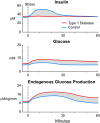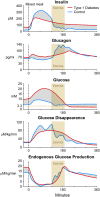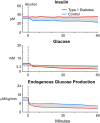Closed-loop artificial pancreas systems: physiological input to enhance next-generation devices
- PMID: 24757225
- PMCID: PMC3994931
- DOI: 10.2337/dc13-2066
Closed-loop artificial pancreas systems: physiological input to enhance next-generation devices
Abstract
To provide an understanding of both the preclinical and clinical aspects of closed-loop artificial pancreas systems, we provide a discussion of this topic as part of this two-part Bench to Clinic narrative. Here, the Bench narrative provides an in-depth understanding of insulin-glucose-glucagon physiology in conditions that mimic the free-living situation to the extent possible in type 1 diabetes that will help refine and improve future closed-loop system algorithms. In the Clinic narrative, Doyle and colleagues compare and evaluate technology used in current closed-loop studies to gain further momentum toward outpatient trials and eventual approval for widespread use.
Figures




References
-
- Rizza RA, Gerich JE, Haymond MW, et al. Control of blood sugar in insulin-dependent diabetes: comparison of an artificial endocrine pancreas, continuous subcutaneous insulin infusion, and intensified conventional insulin therapy. N Engl J Med 1980;303:1313–1318 - PubMed
-
- Phillip M, Battelino T. Atlas E, et al. Nocturnal glucose control with an artificial pancreas at a diabetes camp. N Engl J Med 2013;368:824–833 - PubMed
Publication types
MeSH terms
Substances
Grants and funding
LinkOut - more resources
Full Text Sources
Other Literature Sources
Medical

